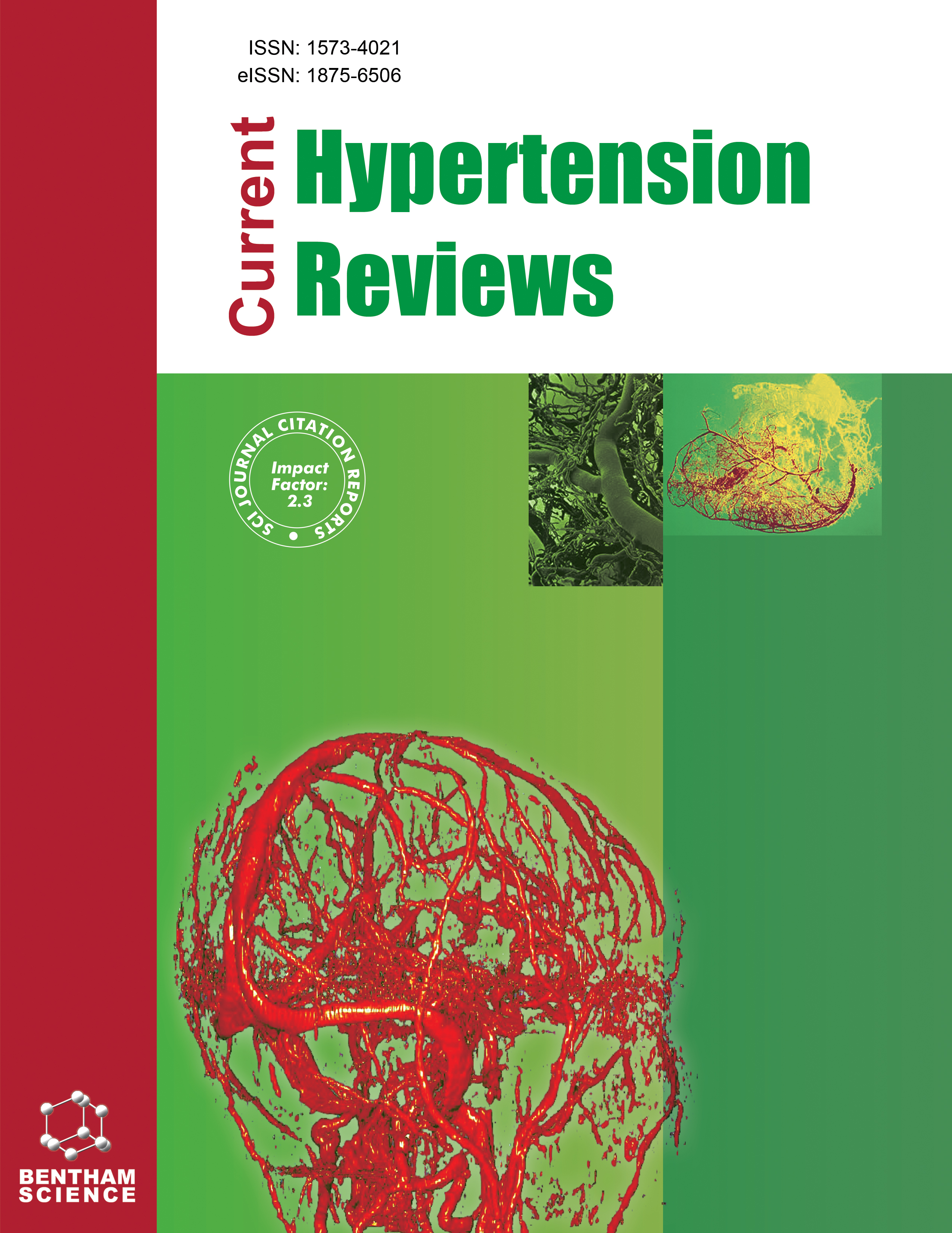- Home
- A-Z Publications
- Current Hypertension Reviews
- Previous Issues
- Volume 8, Issue 2, 2012
Current Hypertension Reviews - Volume 8, Issue 2, 2012
Volume 8, Issue 2, 2012
-
-
Clinical Assessment of Central Blood Pressure
More LessCentral aortic blood pressure (CBP) is increasingly considered a better cardiovascular prognostic marker than conventional cuff brachial blood pressure. Because CBP cannot be directly measured noninvasively, it has to be estimated from peripheral pressure pulses. To assess estimated CBP appropriately, the accuracy and features of the estimation method should be considered. The aim of this review is to provide basic kno Read More
-
-
-
Thresholds for Central Blood Pressures and Augmentation Indices - are They Needed and How Far are We in the Process of Their Definition?
More LessAuthors: Angela J. Woodiwiss and Gavin R. NortonAs central (aortic) blood pressures and augmentation indices predict cardiovascular outcomes beyond brachial blood pressures, there is growing clinical interest in the measurement of central haemodynamics. However, before these measurements can be implemented in clinical practice, determination of normal reference values is mandatory. A rigorous step-wise process is required to define accurate thresholds, so that Read More
-
-
-
Central Blood Pressure and End-organ Damage
More LessWhile the majority of cross-sectional publications report that central blood pressure (BP) is more closely associated with end organ damage, which includes left ventricular hypertrophy, carotid atherosclerosis, and brain and renal damage, than is peripheral BP, the superiority of central BP over peripheral BP has not been consistently observed in recent studies. This discrepancy may be due to a recent finding demonstrating the Read More
-
-
-
Central Blood Pressure and Prediction of Cardiovascular Events
More LessAuthors: Junichiro Hashimoto and Sadayoshi ItoCardiovascular disease is the leading cause of death worldwide. Hypertension is a major contributor to cardiovascular risk, and the blood pressure serves as an important biomarker of the diagnosis, prognosis and treatment. Compared with the blood pressure conventionally measured in the brachial artery, the blood pressure in the central aorta is more strongly influenced by aortic stiffness and peripheral wave reflection, bot Read More
-
-
-
Differential Impacts of Antihypertensive Drugs on Central Blood Pressure and Their Clinical Significance
More LessAuthors: Yoshio Matsui and Kazuomi KarioRecent evidence suggests that central blood pressure (BP) is a more important determinant of cardiovascular risk than is brachial BP. Antihypertensive drugs with vasodilating properties have a more beneficial effect on central systolic BP and pulse pressure by decreasing arterial stiffness and/or the magnitude of wave reflections than thiazide diuretics and β-blockers. These differential effects of antihypertensive dr Read More
-
-
-
Hypertension in Pregnancy: Clinical Manifestations and Treatment
More LessAuthors: Sophia Masoura and Ioannis KalogiannidisAlmost 10% of pregnancies are complicated with hypertension. Chronic hypertension, gestational hypertension, preeclampsia and preeclampsia superimposed on chronic hypertension is the most reliable classification in obstetrical practice. Blood pressure higher than 140/90 mmHg before 20 weeks of gestation is defined as chronic hypertension. Almost 25% of women with chronic hypertension will develop preeclampsia durin Read More
-
-
-
Diabetes and Gestational Hypertension
More LessGestational hypertension, preeclampsia, and diabetes are all associated with increased risks of poor maternal and perinatal outcome. In preeclampsia, exaggerated responses of insulin resistance, altered immune responses and inflammatory pathway activation are reminiscent of metabolic syndrome, and also are evident in gestational diabetes mellitus. Poor glycaemic control, preexisting hypertension and diabetic Read More
-
-
-
Oxidative Stress, Preeclampsia and Cardiovascular Disease
More LessAuthors: S. Iliadis and G. PapageorgiouHypertensive disorders in pregnancy, such as preeclampsia/eclampsia, gestational hypertension and chronic hypertension, account for serious adverse outcome for mother and fetus. Oxidative stress, defined as the imbalance between oxidative and antioxidant mechanisms, is present in multiple disorders, as well as in pregnancy. It is characterized by increased free radical generation, affecting all macromolecules. Pathop Read More
-
-
-
Automated Office Blood Pressure-Eliminating White Coat Hypertension in Clinical Practice
More LessManual blood pressure (BP) measurement performed according to established guidelines has been the standard method for assessing an individual’s BP status. However, manual BP readings in routine clinical practice rarely adhere to these guidelines with the result that routine office BP is relatively less accurate and about 10/5 mmHg higher than readings taken in the same patient as part of a research study. Automat Read More
-
-
-
Passive Smoking, Endothelial Dysfunction and Related Markers in Healthy Individuals: An Update
More LessBy the analysis of previous studies, functional and biochemical markers related to environmental tobacco smoke (ETS) exposure are discussed. 18 healthy never smokers, 12 men (67%) and 6 women (33%) aged from 21 to 55 years (mean: 34+/-9 ys.) underwent experimental procedures twice. in a smoking free environment and in the same environment polluted by 35 ppm carbon monoxide derived from smoked cigarettes. Bra Read More
-
-
-
The Control of Arterial Hypertension: Epidemiological and Economic Challenge
More LessAuthors: Aldo Leone, Emilio Centaro and Aurelio LeoneHypertension is one of the major risk factors for cardiovascular disease and fatal or non-fatal cardiac and cerebrovascular complications. Kidney and retina are also target organs of blood pressure rise. Progressive changes in the definition of hypertension have occurred in the years and blood pressure 130/85 mm Hg is considered as normal. Ischaemic heart disease, particularly myocardial infarction, often unrecognized, as wel Read More
-
Volumes & issues
-
Volume 21 (2025)
-
Volume 20 (2024)
-
Volume 19 (2023)
-
Volume 18 (2022)
-
Volume 17 (2021)
-
Volume 16 (2020)
-
Volume 15 (2019)
-
Volume 14 (2018)
-
Volume 13 (2017)
-
Volume 12 (2016)
-
Volume 11 (2015)
-
Volume 10 (2014)
-
Volume 9 (2013)
-
Volume 8 (2012)
-
Volume 7 (2011)
-
Volume 6 (2010)
-
Volume 5 (2009)
-
Volume 4 (2008)
-
Volume 3 (2007)
-
Volume 2 (2006)
-
Volume 1 (2005)
Most Read This Month
Article
content/journals/chyr
Journal
10
5
false
en


